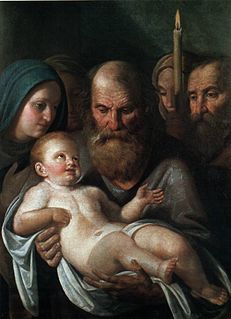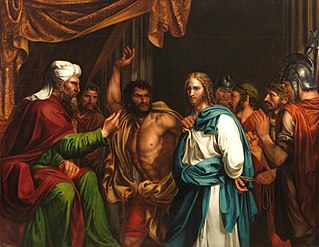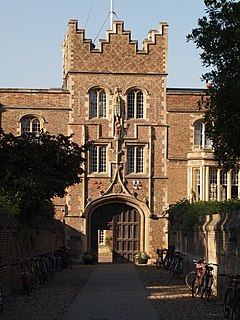
Christianity is rooted in Second Temple Judaism, but the two religions diverged in the first centuries of the Christian Era. Christianity emphasizes correct belief, focusing on the New Covenant as mediated through Jesus Christ, as recorded in the New Testament. Judaism places emphasis on correct conduct, focusing on the Mosaic covenant, as recorded in the Torah and Talmud.

The Gospel according to Matthew, also called the Gospel of Matthew, or simply Matthew, is the first book of the New Testament and one of the three synoptic Gospels. It tells how Israel's Messiah, Jesus, comes to his people and forms a community of disciples, of how he taught the people through such events as the Sermon on the Mount and its Beatitudes, and how Israel becomes divided and how Jesus condemns this hostile Israel. This culminates in his departure from the Temple and his execution. At this point the whole people reject Jesus, and on his resurrection he instead sends the disciples to the gentiles.

Paul, commonly known as Paul the Apostle and Saint Paul, was a Christian apostle who spread the teachings of Jesus in the first-century world. Generally regarded as one of the most important figures of the Apostolic Age, he founded several Christian communities in Asia Minor and Europe from the mid-30s to the mid-50s AD.
The Pharisees were a social movement and a school of thought in the Levant during the time of Second Temple Judaism. After the destruction of the Second Temple in 70 CE, Pharisaic beliefs became the foundational, liturgical, and ritualistic basis for Rabbinic Judaism.
Messianic Judaism is a label attached in recent years to a wide spectrum of modern religious movements. These range from Anglican - the term is owned by some members of Christ Church Jerusalem - to others that are less mainstream. Many members will add elements of Jewish practice to their Christian faith. As a result researchers may simplify and conclude that it only incorporates some elements of Christian Doctrine with staunchly Jewish tradition and practice.

Ebionites as a term refers to a Jewish Christian sect who were vegetarians, viewed poverty as holy, believed in ritual ablutions, and rejected animal sacrifices. They existed during the early centuries of the Common Era. The Ebionites embraced an adoptionist Christology, thus understanding Jesus of Nazareth as a mere man who, by virtue of his righteousness, was chosen by God to be a true prophet. A majority of the Ebionites rejected as heresies the proto-orthodox Christian beliefs in Jesus's divinity and virgin birth. They maintained that Jesus was the natural son of Joseph and Mary who became the Messiah because he obeyed the Jewish law.
Antinomianism is any view which rejects laws or legalism and argues against moral, religious or social norms, or is at least considered to do so. The term has both religious and secular meanings.

In the New Testament, the Transfiguration of Jesus is an event where Jesus is transfigured and becomes radiant in glory upon a mountain. The Synoptic Gospels describe it, and the Second Epistle of Peter also refers to it. It has also been hypothesized that the first chapter of the Gospel of John alludes to it.

Joseph ben Caiaphas, known simply as Caiaphas in the New Testament, was the Jewish high priest who, according to the gospels, organized a plot to kill Jesus. He famously presided over the Sanhedrin trial of Jesus. The primary sources for Caiaphas' life are the New Testament, and the writings of Josephus. Josephus records that he was made high priest by the Roman procurator Valerius Gratus after Simon ben Camithus had been deposed
There is no specific doctrinal view of Jesus in traditional Judaism. Monotheism, a belief in the absolute unity and singularity of God, is central to Judaism, which regards the worship of a person as a form of idolatry. Therefore, consideration of Jesus as deity is not an issue in traditional Jewish thought. The rejection of Jesus as Messiah has never been a theological issue for Judaism because Jewish eschatology holds that the coming of the Jewish Messiah will be associated with events that had not occurred at the time of Jesus, such as the rebuilding of The Temple, a Messianic Age of peace, and the ingathering of Jews to their homeland.

Jewish Christians were the followers of a Jewish religious sect that emerged in Judea during the late Second Temple period. The Nazarene Jews integrated the belief of Jesus as the prophesied Messiah and his teachings into the Jewish faith, including the observance of the Jewish law. The name may derive from the city of Nazareth, or from prophecies in Isaiah and elsewhere where the verb occurs as a descriptive plural noun, or from both. Jewish Christianity is the foundation of Early Christianity, which later developed into Christianity. Christianity started with Jewish eschatological expectations, and it developed into the worship of a deified Jesus after his earthly ministry, his crucifixion, and the post-crucifixion experiences of his followers. Modern scholarship is engaged in an ongoing debate as to the proper designation for Jesus' first followers. Many see the term Jewish Christians as anachronistic given that there is no consensus on the date of the birth of Christianity. Some modern scholars have suggested the designations "Jewish believers in Jesus" or "Jewish followers of Jesus" as better reflecting the original context.

Jesus, also referred to as Jesus of Nazareth or Jesus Christ, was a first-century Jewish preacher and religious leader. He is the central figure of Christianity, the world's largest religion. Christians believe he is the Son of God and the awaited messiah, prophesied in the Hebrew Bible.

The New Testament provides two accounts of the genealogy of Jesus, one in the Gospel of Matthew and another in the Gospel of Luke. Matthew starts with Abraham, while Luke begins with Adam. The lists are identical between Abraham and David, but differ radically from that point. Matthew has twenty-seven generations from David to Joseph, whereas Luke has forty-two, with almost no overlap between the names on the two lists. Notably, the two accounts also disagree on who Joseph's father was: Matthew says he was Jacob, while Luke says he was Heli.

Matthew 5 is the fifth chapter of the Gospel of Matthew in the New Testament. It contains the first portion of the Sermon on the Mount, the other portions of which are contained in chapters 6 and 7. Portions are similar to the Sermon on the Plain in Luke 6, but much of the material is found only in Matthew. It is one of the most discussed and analyzed chapters of the New Testament. Warren Kissinger reports that among Early Christians no chapter was more often cited by early scholars. The same is true in modern scholarship.

Simeon at the Temple is the "just and devout" man of Jerusalem who, according to Luke 2:25–35, met Mary, Joseph, and Jesus as they entered the Temple to fulfill the requirements of the Law of Moses on the 40th day from Jesus' birth, i. e. the presentation of Jesus at the Temple.

In the New Testament, the Sanhedrin trial of Jesus refers to the trial of Jesus before the Sanhedrin following his arrest in Jerusalem and prior to the trial before Pontius Pilate. It is an incident reported by all three Synoptic Gospels of the New Testament, while the Gospel of John refers to a preliminary inquiry before Annas. The gospel accounts vary on a number of details.

This is a glossary of terms used in Christianity.

The burial of Jesus refers to the burial of the body of Jesus after crucifixion, before the eve of the sabbath described in the New Testament. According to the canonical gospel accounts, he was placed in a tomb by a councillor of the sanhedrin named Joseph of Arimathea,. In art, it is often called the Entombment of Christ.

Christianity in the 1st century covers the formative history of Christianity from the start of the ministry of Jesus to the death of the last of the Twelve Apostles and is thus also known as the Apostolic Age.

Jesus College is a constituent college of the University of Cambridge. The college's full name is The College of the Blessed Virgin Mary, Saint John the Evangelist and the glorious Virgin Saint Radegund, near Cambridge. Its common name comes from the name of its chapel, Jesus Chapel.















